#Battery Boost Services
Explore tagged Tumblr posts
Text

A1 Active Towing: Calgary’s Reliable Boosting Experts Anytime, Anywhere
Count on A1 Active Towing for quick and professional boosting experts Calgary services. Our team provides efficient jump-starts, ensuring you’re back on the road in no time. Available 24/7, we’re here to assist whenever you face a dead battery.
0 notes
Text
Mac Password Removal: Hassle-Free Access to Locked Devices
Apple’s Mac computers are renowned for their security features, with password protection being one of the primary ways to secure user data. However, there are times when users may forget their password, find themselves locked out of their MacBook, or inherit a secondhand device with a password they don’t know. When this happens, Mac password removal services can be the solution, providing hassle-free access to locked devices without the frustration of data loss.
Mac Password Protection
Password protection on a Mac is an essential feature designed to protect sensitive data from unauthorized access. Whether it’s an Apple ID password for iCloud or the local system password for logging into the Mac, these security measures ensure that personal files, banking information, and other sensitive content are kept safe.
When users set a password, it encrypts their files and prevents anyone from accessing the device without entering the correct credentials. Unfortunately, in some cases, passwords can be forgotten, misplaced, or inaccessible, leading to the need for Mac password removal.
Common Scenarios That Require Mac Password Removal
While Mac password protection is essential, there are a few common situations in which a user might find themselves locked out of their device. Here are some typical scenarios where password removal services become necessary:
1. Forgotten User Password
One of the most common reasons people need Mac password removal is simply forgetting their user password. It’s easy to forget passwords, especially if you have multiple devices or passwords for various services. A forgotten Mac password can lock users out of their own device, preventing them from accessing important files, applications, and settings.
2. Password Change or Miscommunication
In the case of shared devices or family-owned Macs, passwords can be changed without the user’s knowledge. This could also occur if a password was set by someone else, such as a former employee or a friend, and the user no longer has access to it.
3. Secondhand Mac Devices
Buying a secondhand MacBook can be a great way to save money, but sometimes, these devices are still locked with a password set by the previous owner. This is especially problematic when the previous owner has forgotten or neglected to remove the password before selling or giving away the device.
4. iCloud Account Lock
Another common issue arises when users forget the Apple ID or iCloud password linked to their Mac. This can prevent access to the system or lead to issues with iCloud features like Find My Mac, data syncing, and app store downloads. Apple’s security measures make it difficult to bypass iCloud locks without proper credentials.
5. Hardware Malfunctions
In some cases, Mac password-related issues may arise due to software corruption, a failed system update, or hardware malfunctions that prevent users from logging in. In these cases, password removal may be part of a larger repair or system recovery process.
How Professional Mac Password Removal Services Work
If you find yourself locked out of your Mac, professional password removal services can help you regain access quickly and safely. The process usually involves specialized tools and techniques that ensure you don’t lose data in the process. Here’s an overview of how professional services generally work:
1. Initial Assessment
When you bring your Mac to a professional repair service, the technician will first assess the situation. They will identify the type of password issue you’re facing, whether it’s a forgotten user password, an iCloud lock, or another problem. Depending on the severity of the issue, the technician will determine the best course of action.
2. Data Backup (If Possible)
Before proceeding with password removal, reputable repair services will often back up any accessible data on the device. This is an important step in case the removal process involves erasing the device’s contents. This ensures that no valuable files, documents, or media are lost during the process.
3. Password Removal or Reset
Once the technician has evaluated the device and backed up the data, they will proceed with the password removal or reset. There are various methods for this process:
Password Reset Tools: If the MacBook is running macOS, a technician can use specialized tools to bypass or reset the password, allowing the user to regain access without deleting files.
Apple ID Recovery: If the issue is related to iCloud or Apple ID, technicians can assist in recovering the Apple ID credentials through Apple’s account recovery process. This often involves verifying the identity of the user before unlocking the device.
Reinstalling macOS: In some cases, where all else fails, the technician may reinstall macOS, which will effectively remove any password and restore the device to its factory settings. Although this method may result in data loss, it is sometimes the only viable option when other methods don’t work.
4. Verification and Testing
After the password has been removed or reset, the technician will test the Mac to ensure that it boots up correctly and that all features are functioning as expected. The device will be fully tested to ensure it is accessible and ready to use once again.
5. Providing New Password Setup
Once the device is unlocked, the technician may assist the user in setting up a new password or passcode to secure their device moving forward. They may also recommend setting up security questions or enabling two-factor authentication for added protection.
Why Choose Professional Mac Password Removal Services?
While there are DIY methods available online for removing Mac passwords, they often come with risks. Using unverified tools can damage your MacBook, result in data loss, or even cause additional security vulnerabilities. Here's why professional services are the best choice for password removal:
1. Expertise and Experience
Certified technicians who specialize in MacBook repairs and password recovery know the ins and outs of Apple devices. They have the knowledge and tools to safely remove passwords without damaging the system or compromising security.
2. Safe and Secure
Professional password removal services ensure your data is safe. Reputable services use secure methods that protect your privacy and ensure no data is lost unless absolutely necessary.
3. Preserving Warranty
Attempting password removal using third-party software or DIY methods may void your warranty or damage the device further. Professional services are more likely to preserve your warranty and ensure the device is repaired without compromising its integrity.
4. Time-Saving
Password removal can be a time-consuming process if attempted on your own. Professional technicians can complete the task quickly and efficiently, allowing you to get back to using your MacBook without prolonged downtime.
Whether you’ve forgotten your password, are dealing with a secondhand device, or need to regain access due to a malfunction, Mac password removal services provide a reliable solution for unlocking your device. These services are fast, secure, and professional, ensuring that you regain full access to your MacBook without the risk of data loss or further complications.
By choosing a trusted service provider, you can rest assured that your MacBook will be restored to full functionality quickly, allowing you to get back to your tasks without delay. Always choose a certified and reputable repair center to ensure that the password removal process is done correctly and securely.
#MacBook Repair Calgary#Apple MacBook Services#MacBook Screen Fix#MacBook Battery Replacement#MacBook Keyboard Repair#MacBook Water Damage#MacBook Logic Board Repair#MacBook Performance Boost#Affordable MacBook Repair#MacBook Software Support
0 notes
Text
Juniors Roadside Service

Address:
Amarillo, Texas, 79109, USA
Phone:
(806) 410-4839
Website:
Email:
Description:
Juniors Roadside Service is a premier provider of comprehensive roadside aid across the Texas Panhandle. With decades of experience, we excel in assisting both personal cars and specialized heavy-duty vehicles like 18-wheelers and concrete mixers. Our range of services includes tire replacements, battery jumpstarts, fuel deliveries, and more. Our dedicated team, renowned for its professionalism and rapid response, serves various areas including Amarillo, Canyon, Dumas, Hereford, Stratford, Borger, Pampa, and many other towns. With a strong reputation for reliability and a superb customer service, we are ready to assist whenever you need us. Serving both the English and Spanish-speaking communities, we're proud to announce: Hablamos Español
Hours:
Monday – Saturday 8:00am - 10:00pm, Sunday – CLOSED
Owner Name:
Junior Cera
Social Media Links:
#roadside assistance amarillo#emergency tire change canyon#car battery jumpstart dumas#vehicle lockout service hereford#semi truck assistance amarillo#battery boost services stratford#fuel delivery service panhandle#heavy duty tire repair amarillo#roadside help canyon#quick battery jump dumas#flat tire services hereford#roadside recovery amarillo#emergency roadside stratford#breakdown assistance panhandle#mobile tire repair amarillo#car jumpstart service canyon#emergency assistance dumas#roadside service provider hereford#vehicle recovery service stratford#highway roadside assistance panhandle#auto battery assistance amarillo#truck tire repair canyon#on-the-road assistance dumas#roadside service technician hereford#car emergency services stratford#mobile battery replacement panhandle#roadside service amarillo#battery service canyon#emergency car service dumas.
1 note
·
View note
Text
Are you looking for Best Battery Boost Services in Calgary at affordable prices?
We’ll deliver battery boosting services in Calgary to your pin location in no time, whenever or wherever your vehicle’s battery decides to take a nap in Calgary. We will supply you with a rapid and economical battery boosting or jump-start service, removing the stress from this inconvenient situation.

Contact Roadways Towing whenever your vehicle is at pause. We extend a platform to let you get the superlative service in a budget-friendly package.
0 notes
Text
Dandelion News - October 15-21
Like these weekly compilations? Tip me at $kaybarr1735 or check out my Dandelion Doodles on Patreon!
1. EV owners volunteer to drive voters to the polls in 11 states (and you can too)

“ChargeTheVote.org is a nonpartisan voter education and engagement initiative to enhance voter turnout in the 2024 election by providing zero-emission transportation in electric vehicles (EVs) to local polling locations. ChargeTheVote will also host a webinar for those who are interested in participating this coming Tuesday, October 22 at 7pm Eastern time.”
2. Kenya moves 50 elephants to a larger park, says it’s a sign poaching is low

“The elephant population in the […”Mwea National Reserve”…] has flourished from its capacity of 50 to a whopping 156 […] requiring the relocation of about 100 of [them…. The] overpopulation in Mwea highlighted the success of conservation efforts over the last three decades.”
3. Australian start-up secures $9m for mine-based gravity energy storage technology

““We expect to configure the gravitational storage technology [which the company “hopes to deploy in disused mines”] for mid-duration storage applications of 4 to 24 hours, deliver 80% energy efficiency and to enable reuse of critical grid infrastructure.“”
4. Africa’s little-known golden cat gets a conservation boost, with community help

“[H]unting households were given a pregnant sow [… so that they] had access to meat without needing to trap it in the wild. […] To address income needs, Embaka started […] a savings and loan co-op[… and an] incentive for the locals to give up hunting in exchange for regular dental care.”
5. 4.8M borrowers — including 1M in public service — have had student debt forgiven

“That brings the total amount of student debt relief under the administration to $175 billion[….] The Education Department said that before Biden's presidency, only 7,000 public servants had ever received student debt relief through the Public Service Loan Forgiveness program. […] "That’s an increase of more than 14,000% in less than four years.””
6. Puerto Rico closes $861M DOE loan guarantee for huge solar, battery project
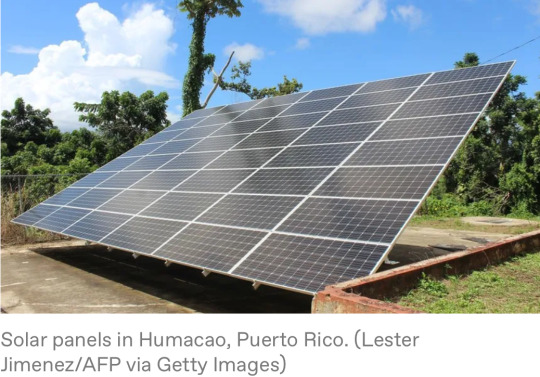
“The solar plants combined will have 200 megawatts of solar capacity — enough to power 43,000 homes — while the battery systems are expected to provide up to 285 megawatts of storage capacity. [… O]ver the next 10 years, more than 90 percent of solar capacity in Puerto Rico will come from distributed resources like rooftop solar.”
7. Tim Walz Defends Queer And Trans Youth At Length In Interview With Glennon Doyle
“Walz discussed positive legislative actions, such as codifying hate crime laws and increasing education[.… “We] need to appoint judges who uphold the right to marriage, uphold the right to be who you are [… and] to get the medical care that you need.””
8. Next-Generation Geothermal Development Important Tool for Clean Energy Economy

““The newest forms of geothermal energy hold the promise of generating electricity 24 hours a day using an endlessly renewable, pollution-free resource[… that] causes less disturbance to public lands and wildlife habitat […] than many other forms of energy development[….]”
9. Sarah McBride hopes bid to be first transgender congresswoman encourages ’empathy’ for trans people

““Folks know I am personally invested in equality as an LGBTQ person. But my priorities are going to be affordable child care, paid family and medical leave, housing, health care, reproductive freedom. […] We know throughout history that the power of proximity has opened even the most-closed of hearts and minds.”“
10. At Mexico’s school for jaguars, big cats learn skills to return to the wild

“[A team of scientists] have successfully released two jaguars, and are currently working to reintroduce two other jaguars and three pumas (Puma concolor). [… “Wildlife simulation”] “keeps the jaguars active and reduces the impact of captivity and a sedentary lifestyle[….]””
October 8-14 news here | (all credit for images and written material can be found at the source linked; I don’t claim credit for anything but curating.)
#good news#hopepunk#electric vehicles#voting#elephant#kenya#conservation#australia#battery#energy storage#africa#cats#hunting#tw animal death#student loans#student debt#debt relief#education#puerto rico#solar#solar panels#solar energy#solar power#tim walz#lgbt#lgbtq#geothermal#renewableenergy#trans rights#transgender
28 notes
·
View notes
Text
SOUDOUGH SALUTATIONS!!!
I am the one and only Carbohydramancer on/ in the @wizard-island-trading-co! I am a Carbohydramancer, that is, a manipulator of Carbohydrates. A bread wizard, basically. My magics are based mostly on semantics. If it can technically be called bread, I can make it.
Pronouns: He/Him
CURRENT STOCK
Battery Acid Hawaiian Buns: An extremely potent electromagical power source. Boosts the power of any electromagical devices and machines hooked up to it. Requires Bottled Lightning and Lithium to bake. Handle only with insulated gloves.
Loaf of Armorsoul: Temporarily boosts defense In organic beings and repairs Automatons when consumed. Any bread baked using @odd-animated-armor's chest cavity results in this bread. This is the only way I've been able to replicate the recipe thus far.
_________________________
UPDATED: Starlight Sourdough: A mystical, mostly untested recipe. A potent, edible source of mana that is arguably more appetizing than a vial of purple goo. I used the Spores of a rare Starlight Mushroom as yeast for a Sourdough Starter, resulting in a promising way to cultivate the notoriously finicky fungus. The recipe has been stabilized, and is being used as a mana power source for @wizard-island-trading-co's Moon-Garden Dyson-Swarm.
Starlight Sourdough-Based effects (made to order):
Total Cleansing: clears all magical status effects and transformations, aside from Trans Magics.
Vitality Enhancement: Enhances your body to handle deadly poisons and fight off any disease or other foreign infection .
SPONTANEOUS MANA COMBUSTION: Causes your mana pathways to overload and have a meltdown that deals devastating damage at the cost of your ability to use magic, at least until you can be properly healed. ⚠️USE WITH EXTREME CAUTION⚠️
_________________________
Bread Bowls full of The Stew: They're bread bowls full of The Stew. Delicious. Mmmm stew. NOT LIABLE FOR ANY INJURY CAUSED BY THE STEW.
Accursed Garlic Bread of Breath Cleansing: Asexual Vampires Rejoice! Consumable for vampires and freshens the breath! All the good of garlic bread with none of the bad! Hurrah! Huzzah!
Sunlight Loaf: Imbued with Radiant Energy, this bread is a bite of sunshine on even the cloudiest of days. It perfectly replicates the nostalgia of Mom's cooking (or nostalgic equivalent) to give a bit of comfort when you need it.
Moonlight Loaf: Baked with Midnight Flour, this bread is a taste of darkness on even the sunniest of days. It perfectly replicates the traumatic experiences of your youth (or any point in your life) to add a dash of despair when you just need a good cry.
CUSTOM ORDERS!!!
Need a pita with a purpose? A magical managerie of baked goods can be at your fingertips! Just tell me the desired effects and I'll see what I can do. I don't take money for my services, however. I take exotic ingredients from which to craft new and exciting pastries.
Please place your orders through the root post or askbox, thanks :)
SOURDOUGH SAYONARA!!!
SECRET BLACK MARKET BREADS:
Biscuit of Testicular Torsion: Leave this unsuspecting biscuit in your victim's fridge. They will eat it, guaranteed. Just wait and listen for the screams. Does not work on those who lack testes.
Baked Horrors: do not. dont. Don't do it you won't like it. Neither will they. Dont.
Bread That Gives @the-gnomish-bastard a migraine every time you take a bite of it: This bread's effects are a mystery.
Not Bread: this is just some gravel I shoveled off of a riverbed.
181 notes
·
View notes
Text

Chemists create gel to prevent leaks and boost lithium-ion battery life
A new type of gel, developed by chemists at the Martin Luther University Halle-Wittenberg (MLU), could help to make lithium-ion batteries safer and more powerful. The gel is designed to prevent the highly flammable electrolyte fluid from leaking. Initial lab studies show that it also improves the performance and service life of the batteries. The researchers have published their work in the journal Advanced Functional Materials. Lithium-ion batteries are real powerhouses. "They charge faster than conventional rechargeable batteries and can therefore be used in almost all areas of life," says Professor Wolfgang Binder, head of the Macromolecular Chemistry Research Group at MLU. "However, the electrolytes, which transport the ions that conduct the current between the electrodes, are highly flammable. This can cause the battery to catch fire or explode if it is damaged."
Read more.
17 notes
·
View notes
Text


Puma Mitsubishi Lancer Evo V
Mitsubishi TEST&SERVICE
Debuted in the second race. In qualifying, he suddenly took the first corner of R. In the finals, he was at the top for a while. 4th place in qualifying (1st in class), 4th in final (1st in class). Driver: Akihiko Nakatani/Sakae Obata.
③Suspension damper is KYB. The spring is Ralliart. ④Safety fuel tank is made by ATN. Capacity is 120ℓ. ⑤The steering wheel is MOMO buckskin. ⑥ The meter is Pi system. On the left is the Omori boost gauge. ⑦The door hinges are carved out because they hit the roll cage. (8, 9) was originally a work RS-Z (8JX 17). The tires are 225/45R17 ADVAN. 1⑩ Replace the radiator with one made by Denso. (11) The oil cooler is genuine. (12) Aero mirror is Valdisport. ⑬The rear is equipped with a differential cooler. LSD is Ralliart (viscous only in the center). (14)The roll bar passes through the bulkhead. The tower bar is Valdisport. There was a WRC plan for the ECU, but the current one is the original. Commercialization is also under consideration. (15)The muffler is thin, about 80mm. (16)The yellow part on the console is the starter, and the one below is the water spray. (17) The roll cage is for FIA-approved rallies. (18) shift is a sword. The knob is a small screwdriver, which is my preference. (19) seats are Valdisport Type II. (20) The roll cage looks like a bird cage. Please compare it with the Impreza on the right.
In the second race, they defeated the Nissan Development Team's GT-R. The tire size/tread has been expanded since Evo IV, reducing the time by approximately 2 seconds.
Exceeded IV in all aspects. There are no flaws!
``The new EVO V has solved all the shortcomings of the EVO IV . In particular, thanks to the wider tread, cornering speed has improved dramatically. It has become my specialty.'' Mr. Yamada of Test & Service maintains the ``Puma Evo,'' which achieved amazing times and came close to the G T-R. When building the vehicle, they placed emphasis on improving the suspension, which is subject to increased strain due to the increased cornering force. Therefore, in testing and service, even if a high input value is added, it cannot be accepted.
I decided to build a strong body. However, the main difference from the Impreza is that instead of welding reinforcement such as adding more spots, the main reinforcement is the extensive use of a strong roll bar that penetrates the body and is also used in WRC. Looking at each part, there are only a few welded parts. The weight is also 30kg more than the standard. This idea is common to the EVO era. With the reinforcement so far, the driver
``I can feel the movement of my feet''
It seems that the comments are satisfying. The engine has a proven track record of being packed to the hilt, starting with the Evo, and is powerful and stable enough to keep its rivals at bay. The cooling performance seems to be high, and the original oil cooler is used as is. “If we keep boiling it down like this, we can last for at least one fight.”
Nakatani seemed to be breathing heavily.
PROVA Eifel Dunlop GC8 Impreza
Debuted in last year's final race! Suddenly took first place in qualifying. This year, he will participate in the second race. 12th place in qualifying (8th in class), retired in finals. Driver: Kazuo Shimizu/Tsutomu Shibuya.
④ The fuel tank is 120ℓ. (5, 6, 7) All aero parts are Prova. The side duct is effective in cooling the brakes. ⑧⑨ The tires are DL/Formula R (205/ 50R16) and the Enkei Sports 7.5J x 16. (10) differential cooler is made by Calsonic. (11) The Prova damper and spring are Swift from Tokyo Spring. (12) Two oil coolers are installed on the engine and one on the transmission. In particular, the latter has a high calorific value and is a must-have item. The radiator is also a large capacity type. ⑬The steering wheel is Impul 913 special. (14)The engine is STi tuned. Management is the same as for WRC cars. The roll cage has been changed and the battery has been made smaller. (15)The seat is full carbon made by Mooncraft. (16) The roll cage is very simple. (17,18) meter is Pi system. On the console, from the right, there is a transmission oil pump, a differential oil pump, and a reserve tank switch for using up to the last liter. Below is a display switch for the Pi data logger. ⑲The square plate visible at the back of the rear center section is the weight. (20) The rear suspension mounting area has been fully reinforced with welding.
This is the first car that Fuji Heavy Industries has officially started working on, from rally to circuit. Once you get used to the world of racing, it can be intimidating.
Unexpected or unexpected. 4 doors are more rigid than 2 doors
``Thanks to the horizontally opposed engine, everything is symmetrical, which means excellent weight balance.This is the lifeblood and appeal of this car.Also, by making full use of the four-wheel drive provided, cornering performance is improved. However, it's the direction of the settings. Thanks to this, the advantage is that you can turn with the same feeling whether it's a rainy day or a sunny day.'' Mr. Fukushima from Bulova Race Garage will be participating in the race. However, the design is older than its rivals, and it seems that the body rigidity is completely lacking, so strengthening it is necessary for the vehicle.
The most important item in production. especially the way it twists
It is said that reinforcement has been focused on the suspension mounting area (to increase suspension rigidity). Also, since last year, the use of flashy two-doors has been allowed in Super Taikyu, but the only reason why four-doors are still used is because they are highly rigid.
The roll cage isn't used much either visually. This was done to reduce weight, and only the minimum necessary parts were included after thorough body reinforcement. The weight was 30kg lighter than the standard, and 30kg was placed as weight on the passenger seat and rear center to thoroughly improve the weight balance. The body is completely finished, but is this it?
Their problem is the engine. It's a little lacking in power. If I go up a little bit more, I can catch up with EVO. It seems like STi's hard work will determine what happens next.
10 notes
·
View notes
Text
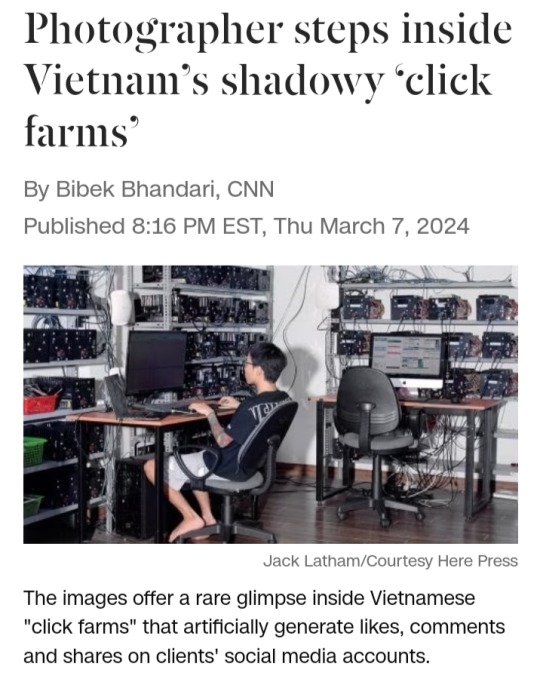
(CNN) — Jack Latham was on a mission to photograph farms in Vietnam — not the country’s sprawling plantations or rice terraces but its “click farms.”
Last year, the British photographer spent a month in the capital Hanoi documenting some of the shadowy enterprises that help clients artificially boost online traffic and social media engagement in the hope of manipulating algorithms and user perceptions.
The resulting images, which feature in his new book “Beggar’s Honey,” provide rare insight into the workshops that hire low-paid workers to cultivate likes, comments and shares for businesses and individuals globally.
“When most people are on social media, they want nothing but attention — they’re begging for it,” Latham said in a phone interview, explaining his book’s title.
“With social media, our attention is a product for advertisers and marketers.”
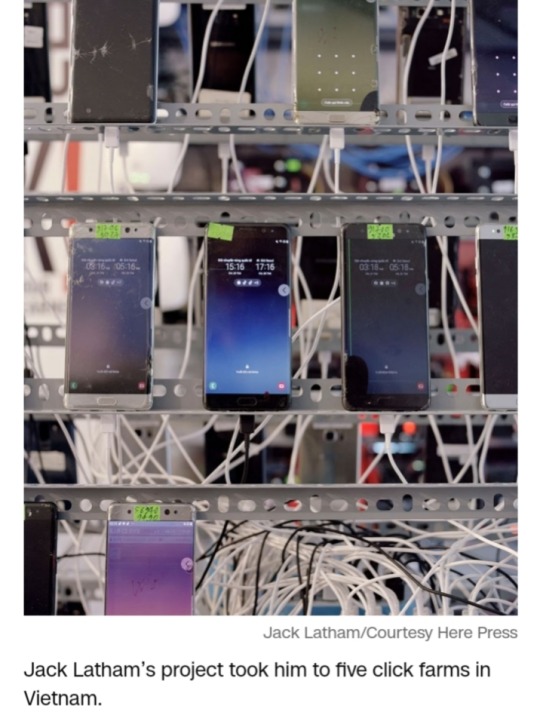
In the 2000s, the growing popularity of social media sites — including Facebook and Twitter, now called X — created a new market for well-curated digital profiles, with companies and brands vying to maximize visibility and influence.
Though it is unclear when click farms began proliferating, tech experts warned about “virtual gang masters” operating them from low-income countries as early as 2007.
In the following decades, click farms exploded in number — particularly in Asia, where they can be found across India, Bangladesh, Indonesia, the Philippines, and beyond.
Regulations have often failed to keep pace: While some countries, like China, have attempted to crack down on operations (the China Advertising Association banned the use of click farms for commercial gain in 2020), they continue to flourish around the continent, especially in places where low labor and electricity costs make it affordable to power hundreds of devices simultaneously.
‘Like Silicon Valley startups’
Latham’s project took him to five click farms in Vietnam.
(The click farmers he hoped to photograph in Hong Kong “got cold feet,” he said, and pandemic-related travel restrictions dashed his plans to document the practice in mainland China).
On the outskirts of Hanoi, Latham visited workshops operating from residential properties and hotels.
Some had a traditional setup with hundreds of manually operated phones, while others used a newer, compact method called “box farming” — a phrase used by the click farmers Latham visited — where several phones, without screens and batteries, are wired together and linked to a computer interface.
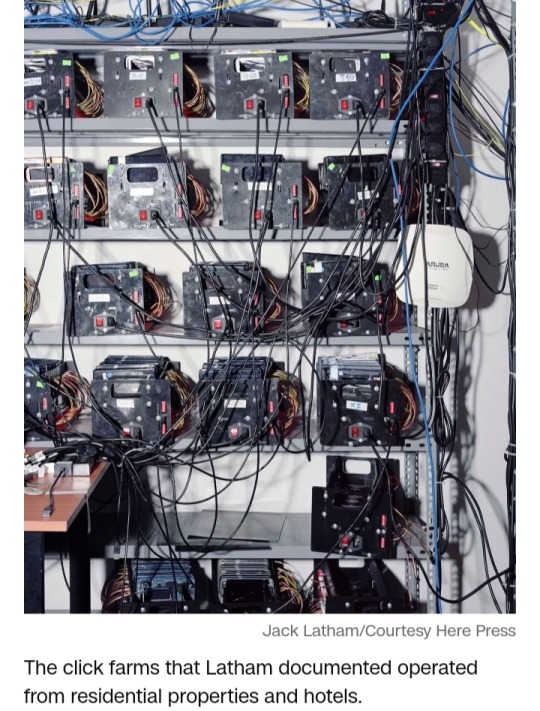
Latham said one of the click farms he visited was a family-run business, though the others appeared more like a tech companies.
Most workers were in their 20s and 30s, he added.
“They all looked like Silicon Valley startups,” he said. “There was a tremendous amount of hardware … whole walls of phones.”
Some of Latham’s photos depict — albeit anonymously — workers tasked with harvesting clicks.
In one image, a man is seen stationed amid a sea of gadgets in what appears to be a lonely and monotonous task.
“It only takes one person to control large amounts of phones,” Latham said. “One person can very quickly (do the work of) 10,000. It’s both solitary and crowded.”
At the farms Lathan visited, individuals were usually in charge of a particular social media platforms.
For instance, one “farmer” would be responsible for mass posting and commenting on Facebook accounts, or setting up YouTube platforms where they post and watch videos on loop.
The photographer added that TikTok is now the most popular platform at the click farms he visited.
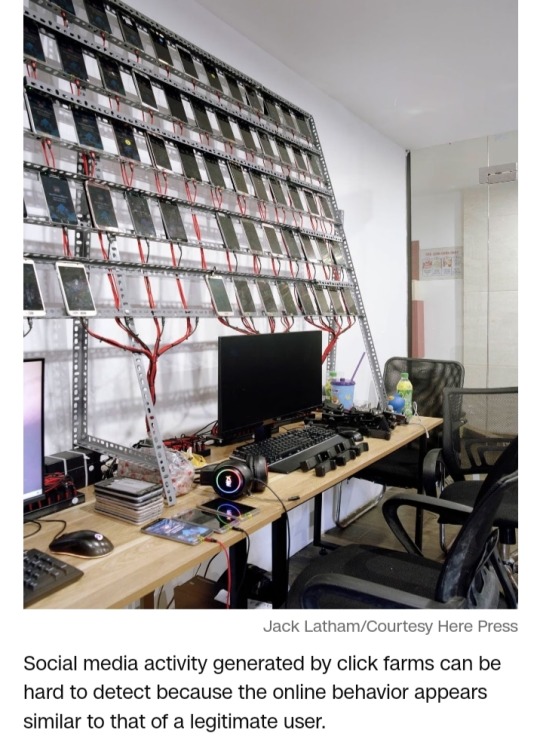
The click farmers Latham spoke to mostly advertised their services online for less than one cent per click, view or interaction.
And despite the fraudulent nature of their tasks, they seemed to treat it like just another job, the photographer said.
‘There was an understanding they were just providing a service,” he added. “There wasn’t a shadiness. What they’re offering is shortcuts.”
Deceptive perception
Across its 134 pages, “Beggar’s Honey” includes a collection of abstract photographs — some seductive, others contemplative — depicting videos that appeared on Latham’s TikTok feed.
He included them in the book to represent the kind of content he saw being boosted by click farms.
But many of his photos focus on the hardware used to manipulate social media —webs of wires, phones and computers.
“A lot of my work is about conspiracies,” Latham said. ” Trying to ‘document the machines used to spread disinformation’ is the tagline of the project. The bigger picture is often the thing we don’t see.”
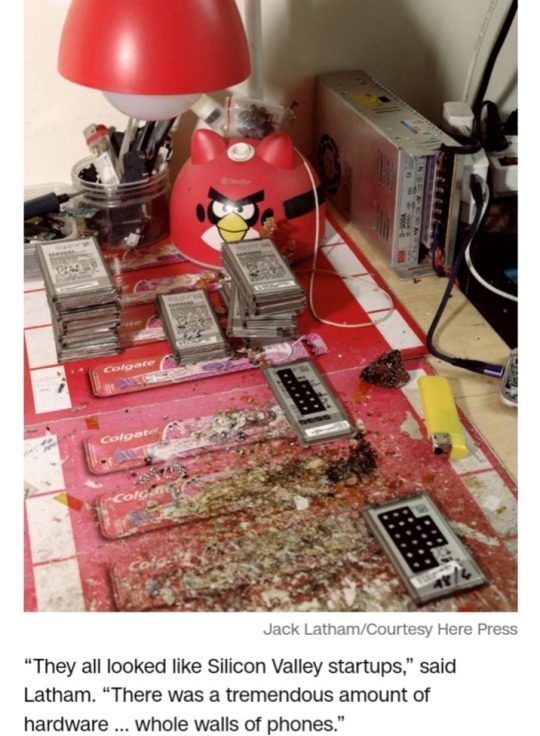
Click farms around the world are also used to amplify political messages and spread disinformation during elections.
In 2016, Cambodia’s then-prime minister Hun Sen was accused of buying Facebook friends and likes, which according to the BBC he denied, while shadowy operations in North Macedonia were found to have spread pro-Donald Trump posts and articles during that year’s US presidential election.
While researching, Latham said he found that algorithms — a topic of his previous book, “Latent Bloom” — often recommended videos that he said got increasingly “extreme” with each click.
“If you only digest a diet of that, it’s a matter of time you become diabetically conspiratorial,” he said.
“The spreading of disinformation is the worst thing. It happens in your pocket, not newspapers, and it’s terrifying that it’s tailored to your kind of neurosis.”
Hoping to raise awareness of the phenomenon and its dangers, Latham is planning to exhibit his own home version of a click farm — a small box with several phones attached to a computer interface — at the 2024 Images Vevey Festival in Switzerland.
He bought the gadget in Vietnam for the equivalent of about $1,000 and has occasionally experimented with it on his social media accounts.
On Instagram, Latham’s photos usually attract anywhere from a few dozen to couple hundred likes.
But when he deployed his personal click farm to announce his latest book, the post generated more than 6,600 likes.
The photographer wants people to realize that there’s more to what they see on social media — and that metrics aren’t a measurement of authenticity.
“When people are better equipped with knowledge of how things work, they can make more informed decisions,” he said.
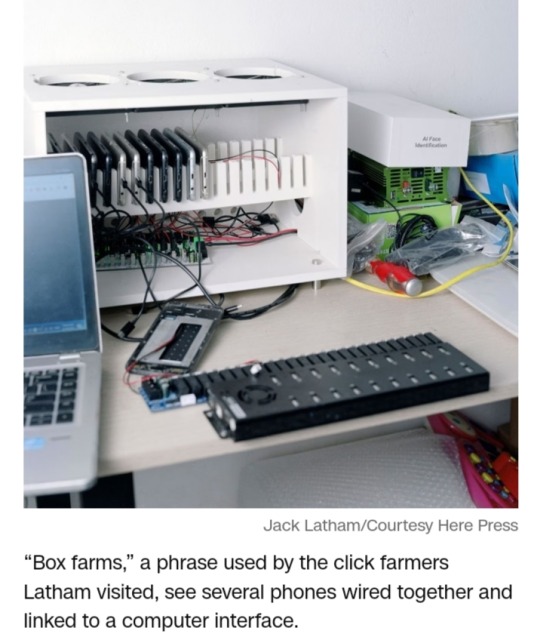
“Beggar’s Honey,” co-published by Here Press and Images Vevey, is available now.
#Jack Latham#click farms#box farms#Hanoi#Vietnam#Beggar’s Honey#box farming#social media#algorithms#user perception#trolls#PR#marketing#advertising#likes#comments#shares#digital profiles#virtual gang masters#bots#spam#China Advertising Association#click farmers#mass post#disinformation#misinformation#fake news#metrics
13 notes
·
View notes
Text
a bunch of mostly unrelated bug fables headcanons
becaudse we keep Thinking while trying to sleep
the ancient crown does not have inherent mind controlling abilities, all it does is amplify the abilities that its wearer already has. in hoaxe's case, along with his fire magic, it boosted his species' mimicry from "make everyone think you're a wasp" to "make everyone think you're the king of the wasps"
zasp comes from a mixed hive of different paper wasp species in the attic/rafters of the giant's lair, which had access to a lot of giant devices that required electricity. his old job in his hive was using his electric magic to power these devices and he left both because of the danger and he was tired of being a battery
vi thinks of "violet" as a sort of Special Sister Name that only jaune is allowed to call her, hence why jaune is the only bug to ever mention it. if anyone else called vi that she would either not respond or try to fight them, or both
ants, bees, wasps, termites, mantis, and roaches all have thumbs but everybody else has just two fingers. this is just more of an art style thing though
zombugs need to eat more than regular bugs or else the fungus will start to eat more of the host body to get its Nutrience. since leif was sort of preserved by the spiderweb and has more access to food, their body is still mostly intact, but the rest of them are more mushroomy because they can't get as much to eat
spiders are awakened, but their social structure and general life is very, very different from bugs, and they just don't care enough to think of bugs as anything other than food. the one spider in the forsaken lands is only an outlier in letting a termite teach her to write, all the others are just as intelligent but show it way differently
the hologram roach in the cave of trials is sapient and is mostly putting on a Customer Service Voice for everyone who uses the training program. when the crystal that turns the program on is removed the hologram is basically asleep, but when it's awake it can hold conversations and entertain itself with the data it stores
before becoming an explorer, leif practically lived at the ant kingdom's theater. they were a cast member of some of the first shows ever put on there and that's how they met muse! in the present day they still like to come back and help with productions when they have the time
jayde is a hornet, not a yellowjacket, and she and fuff are close siblings even though they're different species of hornet (some of the yellowjackets are different species too, there's both the common and aerial kinds in the hive)
yin chews on Everything. she's like the very hungry caterpillar if it continued to be very hungry after growing up. she will put anything in her mouth: crayons. sand. maki's sword. most of the time she chews on her own neck fluff
#this got super long we're not making it shorter#look at our headcanons boy#some of these aren't even headcanons they are just the things we know to be true#bug fables#bug fables spoilers
65 notes
·
View notes
Text
Expert MacBook Screen Repairs: Clear Display, Seamless Performance
A MacBook's screen is one of its most defining features, delivering crisp visuals, vibrant colors, and a seamless user experience. Whether you use your MacBook for professional work, creative projects, or personal tasks, a clear and functional display is vital. Unfortunately, screen issues such as cracks, flickering, or unresponsiveness can disrupt your workflow and compromise your device’s performance.
If you’re dealing with screen damage or display malfunctions, expert MacBook screen repair services can restore your laptop to its optimal state. In this article, we’ll explore common MacBook screen issues, the importance of professional repair, the repair process, and how to choose the right service provider for your needs.
Common MacBook Screen Issues
MacBook screens are designed to provide exceptional quality and durability, but they are not immune to damage or technical problems. Below are some of the most common screen-related issues faced by MacBook users:
1. Cracked or Broken Screens
Accidental drops or impacts can cause physical damage to the screen, resulting in cracks or shattering. Even minor cracks can worsen over time, affecting visibility and touch functionality.
2. Dead Pixels
Dead or stuck pixels appear as small black or discolored spots on the screen. While they may seem minor, they can be distracting and diminish the quality of your display.
3. Flickering or Dim Screens
A flickering or dim screen can result from issues with the backlight, display cable, or graphics processing unit (GPU). This problem can strain your eyes and make it difficult to use your MacBook for extended periods.
4. Unresponsive Displays
Touchscreen MacBooks or trackpads may fail to respond to input, often due to internal hardware issues or software glitches.
5. Screen Discoloration or Distortion
Color distortions, washed-out visuals, or random lines on the display can indicate problems with the screen panel or connections.
6. Black Screen Issues
A completely black screen, despite the device being powered on, is a critical issue often linked to the display connectors or the logic board.
Why Professional Screen Repairs Matter
MacBook screens are intricate components that require expert handling. Attempting to repair the screen yourself or choosing an inexperienced technician can lead to further damage, higher costs, or even render your device unusable.
Benefits of Professional MacBook Screen Repairs
Precise Diagnostics Professional technicians can accurately identify the root cause of screen issues, ensuring that repairs address the underlying problem rather than just the symptoms.
Use of Genuine Parts Reputable repair services use high-quality, genuine replacement parts that meet Apple’s standards. This ensures durability and optimal performance.
Expertise and Experience Certified technicians have the skills and experience to handle complex MacBook screen repairs, including working with Retina displays and advanced screen technologies.
Preservation of Device Integrity Professionals take care to repair or replace the screen without causing damage to other components, preserving the overall functionality of your MacBook.
Warranty and Assurance Most professional repair services offer warranties on parts and labor, giving you confidence in the quality of the repair.
The MacBook Screen Repair Process
The process of repairing a MacBook screen involves several meticulous steps. Here’s an overview of what you can expect when seeking professional repair services:
Step 1: Initial Assessment and Diagnostics
Technicians begin by thoroughly inspecting your MacBook to diagnose the issue. They identify whether the problem lies with the screen itself, the connectors, or other internal components.
Step 2: Disassembly
If a screen replacement is necessary, the technician carefully disassembles the MacBook using specialized tools to access the damaged display. This step requires precision to avoid harming other delicate components.
Step 3: Replacement or Repair
Depending on the diagnosis, the screen may be repaired (e.g., fixing connectors or backlight issues) or replaced entirely. High-quality replacement screens are installed to ensure compatibility and performance.
Step 4: Reassembly
After the repair or replacement, the technician reassembles the MacBook with care, ensuring all components are securely in place.
Step 5: Testing and Quality Assurance
The repaired MacBook undergoes rigorous testing to confirm that the screen functions properly. This includes checking brightness, touch responsiveness (if applicable), color accuracy, and overall display performance.
Choosing the Right Screen Repair Service
Selecting a reliable MacBook repair provider is crucial to ensure your device is in good hands. Here are some factors to consider:
1. Certification and Experience
Opt for repair centers with Apple-certified technicians who specialize in MacBook repairs. Their expertise guarantees high-quality service.
2. Genuine Parts
Verify that the repair service uses authentic replacement screens and components to maintain the integrity and performance of your MacBook.
3. Transparent Pricing
Choose a service provider that offers upfront pricing and clear communication about costs, avoiding unexpected fees.
4. Customer Reviews
Look for reviews and testimonials from previous customers to gauge the quality and reliability of the repair service.
5. Warranty
Reputable repair centers often provide warranties on their repairs, offering peace of mind and protection against future issues.
Preventive Measures to Protect Your MacBook Screen
While accidents can happen, taking precautions can help protect your MacBook screen from damage:
Use a Screen Protector: A high-quality screen protector can shield your display from scratches and minor impacts.
Invest in a Protective Case: A durable case with a padded compartment can prevent damage from drops or bumps.
Handle with Care: Avoid placing heavy objects on your MacBook or exerting pressure on the screen.
Clean the Screen Properly: Use a microfiber cloth and screen-safe cleaning solution to remove smudges and dust without scratching the surface.
A functional and clear MacBook screen is essential for seamless performance, whether you're working, studying, or enjoying multimedia content. When screen issues arise, expert repair services can restore your device to its original condition, ensuring you stay productive without unnecessary interruptions.
By choosing a professional repair provider, you can benefit from precise diagnostics, high-quality parts, and efficient service. Additionally, adopting preventive measures can help prolong the life of your MacBook screen, saving you time and money in the long run.
With the right care and expert support, your MacBook can continue delivering exceptional performance and visuals for years to come.
#MacBook Repair Calgary#Apple MacBook Services#MacBook Screen Fix#MacBook Battery Replacement#MacBook Keyboard Repair#MacBook Water Damage#MacBook Logic Board Repair#MacBook Performance Boost#Affordable MacBook Repair#MacBook Software Support
0 notes
Text
For nearly a decade, U.S. trade policy has been remade in the image of a single man: Robert Lighthizer. As President Donald Trump’s trade representative, he turned the United States away from six decades of support for a rules-based, multilateral trading system and toward a robustly nationalist approach. Lighthizer’s successor under President Joe Biden, Katherine Tai, has continued on the path he laid out. Even as most of Trump’s former officials have denounced him as unfit to be president again, Lighthizer has kept the faith—seeing in Trump, as many others do, a flawed vessel for some greater public good. He remains one of Trump’s top policy advisors in the 2024 campaign and would be set for a bigger job—likely Treasury secretary—if Trump wins in November. Lighthizer’s mission of transforming not just U.S. trade policy but broader U.S. international economic policy is just getting started.
Lighthizer’s influence was on full display last month, when Biden traveled to the headquarters of United Steelworkers, North America’s largest industrial union, in Pittsburgh, in the political battleground state of Pennsylvania. Following the visit, the administration announced plans to sharply increase the tariffs on certain Chinese imports that were first imposed, at Lighthizer’s urging, by Trump. This week, following a review by Tai’s office, the administration slapped a 100 percent tariff on imported Chinese electric vehicles and raised the rates on Chinese-made semiconductors, lithium-ion batteries, solar cells, steel, and aluminum. Tai has also launched a new Section 301 investigation—a 1970s-era tool of U.S. trade unilateralism revived by Lighthizer—into Chinese subsidies for the shipbuilding industry. More tariffs are likely to follow. And Lighthizer himself has been counseling Trump to devalue the strong U.S. dollar if he is elected in order to boost U.S. exports—advice that has been widely read as an audition for the Treasury post.
Lighthizer’s growing influence is a warning to U.S. trading partners—including the country’s closest allies—that the aggressive nationalism of Trump’s trade policies is not a passing phase. Instead, the United States has made a choice across both political parties to embrace an “America First” approach to international economic policy. The implications of that choice will play out for years, and likely decades, to come. That makes Lighthizer—following a career spent mostly as a voice in the wilderness decrying the U.S. embrace of free trade and multilateral rules—the man in the middle.
Lighthizer is an unlikely figure to have become the architect of the next generation of U.S. international economic policy. Born just after the end of World War II, he spent most of his career as a lawyer protecting the U.S. steel industry against foreign competition. Once the anchor industry of U.S. manufacturing, steel is now a rounding error in an economy dominated by information technology, a growing green industry, and the exploding international trade in services, including higher education and tourism. But the lessons he learned from steel—that U.S. trading partners engage in predatory practices, including by subsidizing production and dumping goods below their cost, that have stolen U.S. jobs and hollowed out manufacturing—have now become gospel for trade officials in both parties.
Lighthizer’s 2023 book, No Trade Is Free, is a searing indictment of the many decades of consensus on the benefits of trade liberalization. From Franklin D. Roosevelt to Barack Obama, U.S. presidents believed that negotiated reductions of global trade barriers would make the United States and the world richer and safer. Lighthizer always disagreed. But after a brief stint at the Office of the U.S. Trade Representative during the Reagan administration, he fell into obscurity, resurfacing every so often at congressional hearings, most notably to warn against admitting China to the World Trade Organization (WTO), which happened in 2001. His book, written after Trump’s 2020 election defeat, is an “I told you so” to the U.S. trade establishment. Reducing tariffs and binding Washington’s hands through global trade rules was, he writes, “a starker, more indisputable failure than even I could have predicted,” leading to the loss of U.S. manufacturing, the stagnation of Americans’ wages, and a U.S. strategic position that has deteriorated sharply against China. But, he argues, the “political establishments of both the Republican and Democratic parties, under the influence of multinational corporations and importers, were unwilling or unable to recognize their mistakes.”
As Trump’s trade representative for the entire four years of his term—a rare accomplishment under a mercurial president—Lighthizer was able to turn the United States onto a different course. He slapped tariffs of up to 25 percent on steel and aluminum imports from much of the world, imposed similar tariffs on three-quarters of China’s exports to the United States, and strong-armed Canada and Mexico into a renegotiation of the North American Free Trade Agreement. These moves were largely popular at home—Democrats rallied behind the new United States-Mexico-Canada Agreement over provisions that tightened labor law enforcement in Mexico and required more production in the United States. The Biden team has also kept the China tariffs in place, despite strong initial opposition from Treasury Secretary Janet Yellen.
But Lighthizer is just getting started. What he envisions, in the simplest terms, is a United States that worries far less about being a stabilizing force in the global economy and far more about pursuing its own narrow economic interests. As Treasury secretary, he would have many more tools at hand to carry out that mission.
The key metric for Lighthizer is one that conventional economists rarely pay attention to: the trade deficit. The United States has run a deficit in goods and services every year since 1975, topping out at a whopping $951 billion in 2022, although trade deficits were much higher relative to the size of the economy in the mid-2000s. Most economists, however, consider the trade deficit to be a function of national savings rates—the necessary consequence of high U.S. consumption and low private and public savings—and therefore largely immune to government intervention on the trade side. Lighthizer disagrees, seeing the deficit as a direct transfer of U.S. wealth to competitors, most importantly China, that can be corrected through forceful government action.
He would make it a goal of U.S. policy to balance trade with the rest of the world, not just China. The implications are enormous. One tool, which Lighthizer has reportedly proposed to Trump, is a concerted effort to weaken the U.S. dollar against other currencies. Other things being equal, a cheaper dollar would reduce the prices that foreigners pay for U.S. exports, make imports more expensive for Americans, and help bring trade closer to balance. The dollar, however, has long been overvalued, partly because of its role as the global currency of choice; more recently, it has been soaring in response to a strong U.S. economy and conflicts in the Middle East and Europe that have sent investors running for the safe haven of U.S. assets. Details are scant, but Lighthizer appears to be envisioning a reprise of actions taken by U.S. President Richard Nixon in 1971 and Ronald Reagan in 1987: imposing or threatening tariffs on trading partners unless they agree to take steps to revalue their currencies against the dollar. Given the scale of global financial flows today—a multiple of the level of when Reagan wrestled down the dollar—the consequences of messing with the stability of the currency are hard to predict.
Lighthizer similarly envisions an overhaul of the U.S. tax system to promote the competitiveness of U.S.-based manufacturing. For complicated historical reasons, U.S. exports have long been harmed by the U.S. tax system. Europe and most other countries rely heavily on value-added taxes (VAT), from which goods and services leaving the country are usually exempt. U.S. taxes, on the other hand, are largely income-based, and such taxes are not reimbursable under global trade rules. A U.S. company exporting to Europe pays both U.S. corporate income taxes and the local VAT on its sales in Europe—which puts products made in the United States at a competitive disadvantage. Lighthizer wants that to end by making the corporate tax system “border adjustable” to emulate the advantages of a VAT. Such revisions would have to run a congressional gauntlet, however, and have failed in the past due to pushback from large U.S. importers such as Walmart. Expect a Treasury Secretary Lighthizer to make another run at it.
But Lighthizer’s favorite tool remains the one most clearly controlled from the White House: tariffs. Writing in the Economist in March in defense of Trump’s announced plan to impose sweeping new tariffs if he is elected, he argued that the United States’ “bold experiment” with eliminating tariffs “has failed.” New tariffs—at least 10 percent across the board, in addition to some higher, more targeted duties—are needed “to reduce America’s trade deficit and to speed up its reindustrialisation,” he wrote. “Experience suggests that this will succeed and that high-paying industrial jobs will be created.” His book suggests how far such an effort might go. Tariffs should be imposed on all imports “at a progressively higher rate year after year until we achieve balance.” In other words, a 10 percent minimum on all trade is only the opening bid.
He would further seek to eliminate an obscure provision known as de minimis—the value below which imports are exempt from customs entirely. With the 2015 Trade Facilitation and Trade Enforcement Act, Congress increased that rate from $200 to $800, with the goal of eliminating costly paperwork for smaller shipments of consumer goods. The change happened just as international online ordering was taking off. Consider the Chinese fast-fashion giant Shein, which has grown from a tiny business in 2015 into a giant with at least $30 billion in annual sales that now controls nearly 30 percent of the U.S. fast-fashion market—without a single U.S. store or brand. Downloads of Shein’s shopping app rose from fewer than 3 million globally in 2015 to more than 260 million last year. The company’s business model involves shipping Chinese-made clothing directly to American consumers duty-free because of the de minimis exemption; shipping giants such as FedEx and UPS are happy to cooperate. Lighthizer argues that the provision gives many Chinese companies duty-free access to the U.S. market without requiring any reciprocity.
Lighthizer’s influence will remain, no matter who wins in November. Biden has tried to walk a line between promoting U.S. manufacturing and seeking common ground with allies, who fear growing U.S. protectionism—foreign concerns of which Lighthizer has long been dismissive. But in an election year, the Biden administration’s evenhandedness is disappearing. At the behest of U.S. Sen. Sherrod Brown from Ohio, a Democrat who faces a tough reelection battle in a Trump-leaning state, Biden has promised, for example, to block the proposed takeover of U.S. Steel by Japan’s Nippon Steel. The Japanese company has already pledged to honor all union contracts, move its U.S. headquarters from Houston to Pittsburgh, and not cut jobs or move production overseas. But U.S. labor unions remain opposed to the deal, so Biden has said he will block the takeover on specious national security grounds, a move that is sure to infuriate the most important U.S. ally in the Asia-Pacific.
The areas of common ground between Lighthizer and the Democrats are much deeper than most people recognize. Consider climate change—many Republicans, including Trump, are skeptical of the science and opposed to any government actions to reduce the use of fossil fuels. But Lighthizer strongly favors extra tariffs on carbon-heavy imports, a policy that the European Union is already rolling out and that is now being seriously explored by the Biden administration. Lighthizer favors a carbon border tax that would impose additional tariffs on emissions-intensive products—including cement, fertilizers, and aluminum—with the argument that to do otherwise is to benefit countries producing goods “using much more carbon than we would tolerate here,” he writes in No Trade Is Free.
Under Tai and an emboldened Labor Department, the Biden administration has also become more aggressive in using trade tools to sanction human and labor rights violators around the world. Lighthizer would go much further than that. In his book, he proposes that all imports should be blocked unless the exporting companies adhere to U.S.-level standards for environmental protection, labor rules, and worker health and safety.
The biggest target for each of these initiatives is, of course, China. It was the Trump administration that launched a U.S. policy shift on China, treating it less as a trading partner and more as a hostile adversary. Lighthizer, who played a key role in this shift, minces no words, arguing that China is “the greatest threat that the American nation and its system of Western liberal democratic government has faced since the American Revolution.” He cites as evidence China’s huge economy, almost the size of the United States’, which makes it a far more capable adversary than the former Soviet Union—let alone Nazi Germany or imperial Japan. Lighthizer would seek something close to a full economic decoupling; as a first step, he recommends eliminating China’s “most favored nation” status, granted by Congress in 2000 to permit Beijing’s entry to the WTO. That would give the president a completely free hand to slap discriminatory tariffs on China.
Few on the Democratic side propose to go that far. So far, the Biden team is trying to distinguish between strategic trade with China in products such as semiconductors and new EV technologies that may need to be restricted and most ordinary consumer goods, which can be traded freely. The administration’s strategies—circumscribed with the phrases “small yard and high fence” and “derisking”—still envision a lot of room for mutual gain in U.S.-China trade. But the more China comes to be seen as a threat, the more compelling Lighthizer’s comprehensive decoupling logic will become. Any form of U.S. trade with China is likely to enrich China, potentially making it a more formidable adversary down the road. In an election year, especially, calls for nuance in the U.S.-China relationship are likely to be drowned out.
But while the influence of Lighthizer’s agenda will grow and endure in both parties, the disruptions could be more modest than many observers fear. When Trump imposed his tariffs, the global trade system proved more resilient than once seemed likely, producing only a modest downturn in U.S.-China trade and small uptick in inflation. But there is also a growing danger that a little bit of U.S. protectionism suddenly escalates into something much more harmful. Lighthizer’s colleague-in-arms during the Trump administration, former Director of Trade and Manufacturing Policy Peter Navarro—currently in prison for refusing to cooperate with Congress’s investigation into the Jan. 6, 2021, Capitol attack—wants the United States to demand tariff reciprocity across the board. Any country that refused to reduce its tariff on a product to U.S. levels—Europe’s 10 percent tariff on passenger cars would have to fall to the U.S. rate of 2.5 percent—would face offsetting tariffs. (The Europeans would then likely retaliate by offsetting the United States’ 25 percent tariff on imported SUVs.) The Democrats, too, are eager to slap an array of new tariffs on a host of clean energy products, including wind turbines and EVs; last month, Tai told a congressional committee that the administration would take “early action, decisive action” to protect the U.S. EV industry.
The growing popularity of protectionism in both parties suggests there is much more to come. If other countries respond in kind, which is all but certain, it is easy to envision the sort of damaging trade and currency wars that have not occurred since the 1920s and ’30s.
To be sure, there is no rule that history must repeat itself. The United States could simply be in the midst of correcting trade policies that went too far and too fast in the direction of liberalization, leaving some U.S. industries and workers vulnerable to predatory competition. A middle ground is certainly possible. But all the evidence suggests that the United States is in serious danger of heading too far and too fast in the opposite direction. Should that be in doubt, just take a close look at what Lighthizer—the most important figure in U.S. trade policy to have emerged in our lifetime—has done, is saying, and still plans to do.
6 notes
·
View notes
Text
BEST BRANDS WE ARE DEALING WITH
In Ov mobiles, we specialise in a comprehensive range of mobile services to meet the needs of our customer, dealing with most popular mobile phones based on Thoothukudi ,our offering includes chip level repairs en compassing both Hardware and Software Solutions such as PIN an FRP unlocks. With ensure precision and versatility in customizing mobile accessories and components.
POPULAR PHONES IN INDIA IN 2024
iPhone 16 Pro max
Samsung Galaxy S24 Ultra
iPhone 16
Google pixel 9
Galaxy S24 Ultra
OnePlus Open
Samsung Galaxy Z flip 6
Galaxy S24
Google Pixel 9 Pro
iPhone 14
iPhone 16Pro max
iPhone 16 pro
Galaxy A25 5G
Asus ROG phone 8 Pro
One Plus
Redmi Note 13
We are specially dealing with
Galaxy S 24
Iphone16
Google pixel 9pro
TOP BRAND PHONE IN THOOTHUKUDI
Galaxy S24
The Galaxy S24 series features a "Dynamic AMOLED 2X" display with HDR10+ support, 2600 nits of peak brightness, LTPO and "dynamic tone mapping" technology. we ov mobiles offer u all models use an ultrasonic in-screen fingerprint sensor. The S24 series uses a variable refresh rate display with a range of 1 Hz or 24 Hz to 120 Hz The Galaxy S24 Series introduces advanced intelligence settings, giving you control over AI processing for enhanced functionality. Rest easy with unparalleled mobile protection, fortified by the impenetrable Knox Vault, as well as Knox Matrix13, Samsung's vision for multi-device security. The Galaxy S24 Series is also water and dust resistant, with all three phones featuring an IP68 rating10, so you can enjoy a phone that is able to withstand the demands of your everyday life! definitely this phone will crack the needs of the people in and around thoothukudi.
THE MOST FAVOURITE MOBILE PHONE IN INDIA
Iphone16
The new A18 chip delivers a huge leap in performance and efficiency, enabling demanding AAA games, as well as a big boost in battery life. Available in 6.1-inch and 6.7-inch display sizes, iPhone 16 and iPhone 16 Plus feature a gorgeous, durable design and offer a big boost in battery life. Apple has confirmed that the new iPhone 16 and iPhone 16 Plus models are equipped with 8GB RAM, an upgrade from the 6GB RAM in last year's base models. Johny Srouji, Apple's senior vice president of hardware technologies,
How long does the iPhone 16 battery last? Battery size Battery life (Hrs:Mins) iPhone 16 3,561 mAh 12:43 iPhone 16 Plus 4,674 mAh 16:29 iPhone 16 Pro 3,582 mAh 14:07 iPhone 16 Pro Max 4,685 mAh 17:35 The iPhone is a smartphone made by Apple that combines a computer, iPod, digital camera and cellular phone into one device with a touchscreen interface. iPhones are super popular because they're easy to use, work well with other Apple gadgets, and keep your stuff safe. They also take great pictures, have cool features, and hold their value over time. iOS devices benefit from regular and timely software updates, ensuring that users have access to the latest features and security enhancements. This is in contrast to Android, where the availability of updates varies among manufacturers and models in ov mobiles.
FUTURE ULTIMATE PHONE PEOPLE THINK
Google pixel 9pro
The Google Pixel 9 Pro is the new kid on the block in this year's lineup. The Pixel 8 Pro was succeeded by the Google Pixel 9 Pro XL and the 9 Pro is a new addition to the portfolio - it is a compact, full-featured flagship with all of the bells and whistles of its bigger XL sibling
A compact Pixel is not a new concept in itself, of course, but this is the first time Google is bringing the entirety of its A-game to this form factor. The Pixel 9 Pro packs a 48MP, 5x optical periscope telephoto camera - the same as the Pixel 9 Pro XL. There is also UWB onboard the Pixel 9 Pro. Frankly, it's kind of amazing that Google managed to fit so much extra hardware inside what is essentially the same footprint as the non-Pro Pixel 9.
Google Pixel 9 Pro specs at a glance: Body: 152.8x72.0x8.5mm, 199g; Glass front (Gorilla Glass Victus 2), glass back (Gorilla Glass Victus 2), aluminum frame; IP68 dust/water resistant (up to 1.5m for 30 min). Display: 6.30" LTPO OLED, 120Hz, HDR10+, 2000 nits (HBM), 3000 nits (peak), 1280x2856px resolution, 20.08:9 aspect ratio, 495ppi; Always-on display. Chipset: Google Tensor G4 (4 nm): Octa-core (1x3.1 GHz Cortex-X4 & 3x2.6 GHz Cortex-A720 & 4x1.92 GHz Cortex-A520); Mali-G715 MC7. Memory: 128GB 16GB RAM, 256GB 16GB RAM, 512GB 16GB RAM, 1TB 16GB RAM; UFS 3.1. OS/Software: Android 14, up to 7 major Android upgrades. Rear camera: Wide (main): 50 MP, f/1.7, 25mm, 1/1.31", 1.2µm, dual pixel PDAF, OIS; Telephoto: 48 MP, f/2.8, 113mm, 1/2.55", dual pixel PDAF, OIS, 5x optical zoom; Ultra wide angle: 48 MP, f/1.7, 123-degree, 1/2.55", dual pixel PDAF. Front camera: 42 MP, f/2.2, 17mm (ultrawide), PDAF. Video capture: Rear camera: 8K@30fps, 4K@24/30/60fps, 1080p@24/30/60/120/240fps; gyro-EIS, OIS, 10-bit HDR; Front camera: 4K@30/60fps, 1080p@30/60fps. Battery: 4700mAh; 27W wired, PD3.0, PPS, 55% in 30 min (advertised), 21W wireless (w/ Pixel Stand), 12W wireless (w/ Qi-compatible charger), Reverse wireless. Connectivity: 5G; eSIM; Wi-Fi 7; BT 5.3, aptX HD; NFC. Misc: Fingerprint reader (under display, ultrasonic); stereo speakers; Ultra Wideband (UWB) support, Satellite SOS service, Circle to Search. Google also paid some extra attention to the display of the Pro. It is a bit bigger than the Pixel 8's and better than that inside the regular Pixel 9. The resolution has been upgraded to 1280 x 2856 pixels, the maximum brightness has been improved, and there is LTPO tech for dynamic refresh rate adjustment.
WHY YOU SHOULD CHOOSE OV MOBILES?
you need to choose us because of our great deals and offers which we provide for our customer especially in festival time our offers really attract you without fail. Agreat opportunity in Ov mobiles is when u purchase from our shop in any of the product, we offer you a great percentage of discounts for your next purchase of any models
3 notes
·
View notes
Text
Managed to turn an L into a W today, fuck yeah
Kiddo and I went out to run some errands. On the drive, I had to slam on my brakes to avoid hitting someone. Sounds more dramatic than it was. Well, annoyingly and oddly, a bunch of lights came on. These are all things this car has decided to light up for stupid reasons in the past, so I thought nothing of it. Yeah yeah, ABS, slip, and VDC, I know, whatever. The car is driving normal, so whatever.
An important note: The car is a push start, so you press down the brake pedal then hit a button, and if the key is in the vehicle, it turns on the engine. If you don't press the brake, it enters accessory mode, running on battery.
So, we run into store, they don't even have the thing kiddo wanted, boo. We sit in car. Engine doesn't start, but it enters accessory mode. I try again, watching the display, and it says I need to press the brake to start. But I am. I try again. I try again practically standing on the brake pedal.
I call my husband out of frustration, opening with "Heeeeyyyy, do we still have AAA?" (We do not u_u)
We go over our options, then hang up. I call the dealership we get our services at, and they don't have any suggestions except 'bring it in' of course. I sigh and tell my husband, and we decide to call a tow, because, well, not getting anywhere. Husband borrows Mika's car to come get us.
After I get off phone with tow, getting quoted for $360 for a 40mi tow 😬, I turn to my kid. "I just noticed there's an O'Reillys auto parts right there. Let's go see if they have any suggestions."
They did!
First guy I talk to isn't familiar with push starts, but he asks the next guy who immediately names the part he thinks it is. First guy starts looking up the part for me (brake light switch, which doubles as the electrical impulse for starting the engine), and I ask how hard it is to replace. A 3rd guy tells us it should be easy enough that even my kid can do it.
Well, kiddo was intrigued! We get our $20 part back to the car and I launch a video on the replacement. Not a single tool required, nice. Don't gotta open up the hood or anything, the switch is just above the brake pedal.
I pulled the wire housing off the switch because it took too much finger strength for kiddo. Honestly, was tough for me, too. Then kiddo removed the switch and did most of the replacement of the new one! Husband showed while we were doing the final bit, he went in with his fresh hands and finished it off.
The car started!!!!!
I canceled my tow, then went into the O'Reillys to thank everyone there and let them know it worked, then kiddo and I gave up on most of our outing, got A Little Treat, then went home.
As we left from thanking the guys, I turned to kiddo
"Did fixing the car give you confidence?"
"Actually, yeah! I feel pretty good about that!"
So, hell yeah!!
Then he cooked himself some ramen for dinner!! He's feeling so good and independent after fixing the car x3
And so that's why I consider it an overall Win ☺️ What started as (financially) Scary turned into a $20 confidence boost for kiddo.
#misha rambles#I just got done sending in a little message through their website customer service/ contact us#Just thanking them profusely and hoping they get some good corporate recognition lol#I figure the least i can do is let the powers that be hear about a very good thing they did
2 notes
·
View notes
Text
Unveiling the iPhone 16: A Sleek Design and Powerhouse Features
Apple's iPhone 16 is set to redefine smartphone excellence with a stunning design and a suite of powerful features. This highly anticipated device is poised to captivate users with its sleek aesthetics, cutting-edge technology, and enhanced capabilities. Let's delve into the details and explore what the iPhone 16 has in store.

A Symphony of Design
The iPhone 16 is expected to maintain its signature minimalist design, featuring a sleek, curved body and a premium finish. While rumors suggest subtle refinements to the overall shape, the device is likely to retain its iconic Apple aesthetic. The choice of colors is expected to expand, offering users a wider range of options to suit their personal style.
A Bigger, Brighter Display
One of the standout features of the iPhone 16 is expected to be its display. Rumors point to a slightly larger screen compared to its predecessor, providing an immersive viewing experience for content consumption, gaming, and multitasking. The display is also likely to boast improved brightness and contrast levels, ensuring vibrant visuals even in bright outdoor conditions.
Camera Excellence
Apple has consistently set the bar high for smartphone cameras, and the iPhone 16 is no exception. The device is expected to feature a versatile camera system with multiple lenses, including a primary sensor with a higher megapixel count for improved image quality. Enhanced low-light performance, advanced computational photography features, and improved video capabilities are also anticipated.
A Powerful Performance
Under the hood, the iPhone 16 is rumored to be powered by Apple's latest A-series chip, offering a significant boost in performance compared to its predecessor. This powerful processor will enable seamless multitasking, demanding gaming, and efficient app execution. Combined with Apple's optimized iOS, the iPhone 16 is expected to deliver a smooth and responsive user experience.
Battery Life and Charging
Battery life is a crucial aspect of any smartphone, and the iPhone 16 is anticipated to offer improvements in this area. With advancements in battery technology, users can expect longer battery life, allowing them to enjoy their device without frequent recharging. Additionally, the iPhone 16 may support faster charging speeds, ensuring quick top-ups when needed.
Connectivity and Features
The iPhone 16 is likely to come equipped with the latest connectivity features, including 5G support for blazing-fast internet speeds. Wi-Fi 6E compatibility will also enhance wireless network performance. Other expected features include NFC for contactless payments, Bluetooth for wireless connectivity, and support for various location services.
Conclusion
The iPhone 16 promises to be a remarkable smartphone that combines elegant design with powerful performance. With its upgraded camera system, enhanced display, and cutting-edge features, it is poised to captivate users and set new standards for the industry. As we eagerly await its official release, the iPhone 16 is shaping up to be a worthy successor to Apple's iconic lineup.
3 notes
·
View notes